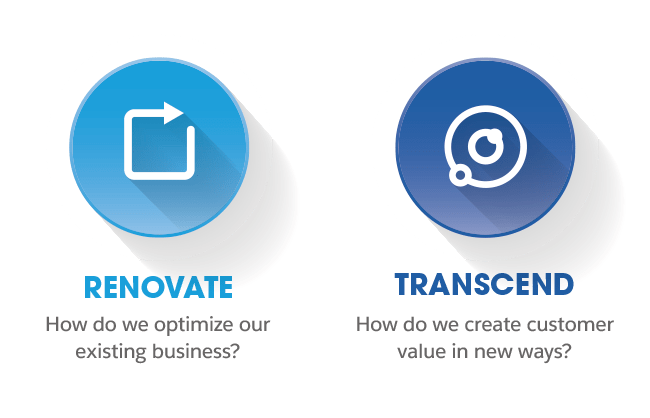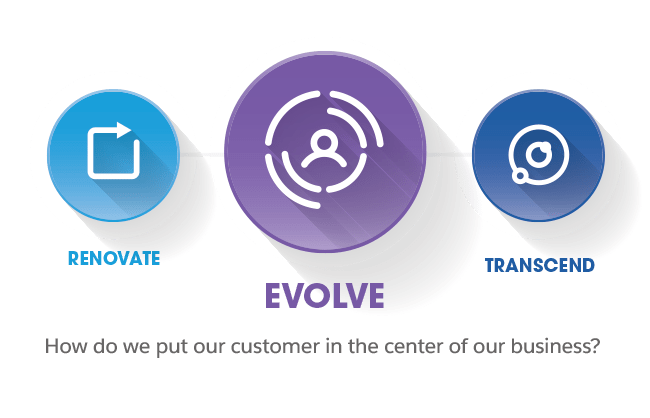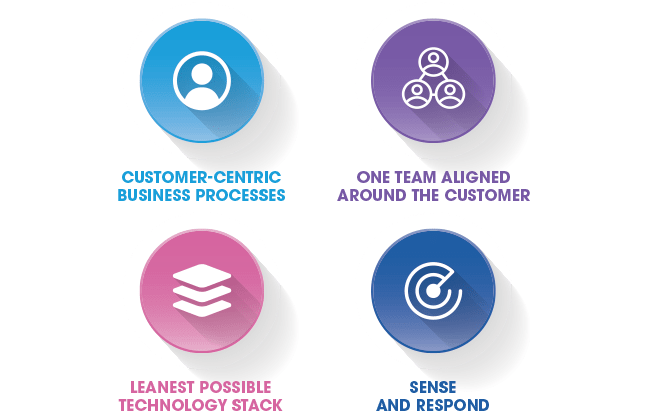What do you need to win in business? A simple question that for decades had clear answers: Size, incumbency, and great products. Leaders thought, “Build it, and they will come,” and so it has been that the product has always been at the center of a business.
Until today. Any digital native starting a company will design their business around the customer. They understand that their future success and growth depend on the customer experience they deliver as they do their products and services. In the digital age, the ability to constantly evolve your business as customer tastes change is critical to survival.
While most existing companies understand this imperative, few are effectively managing to respond. The statistics around digital transformation failures make for dismal reading. Most organizations mistake a long list of expensive digital change initiatives for the solution.
But if there is one important thing Salesforce has learned by helping leaders across every industry: adding new technology to old-fashioned, product-centric thinking doesn’t generate the change businesses really need.
Future-fit companies are redesigning their businesses to compete on the most important market differentiator: their ability to understand, engage, and earn the trust of their customers. These companies now put the customer at the center.
Customer 360 transformation
Drawing from thousands of working sessions and projects with C-suite leaders over the past two decades, we’ve created a playbook focused on what we call customer 360 transformation — an approach that puts the customer in the center of your feedback loop and innovation cycle. Customer 360 transformation rallies every department, employee, and stakeholder around customers’ needs.

Across industries and functions, we’ve found the core challenges are the same — and so are the key questions to ask your teams as you drive a customer-first revolution.
The first step in your transformation is understanding the importance of changing mindsets in your organization.
The critical role of mindsets
Our working sessions with leaders have made it clear: To create change, you need to change how people see the world.
Mindsets are the common assumptions that shape how people behave, either holding companies back or propelling them forward.
Most CEOs look at their business and see two ways to change.
One way is to view today’s technology as the latest flow of incremental innovation with the belief they can optimize the existing business and technology stack to drive down costs and increase productivity. Then all will go back to normal. That’s a renovate mindset.
While the renovate mindset may lead to isolated successes, it is generally a defensive strategy and fails to scale benefits across the company.
A second approach is to use freed-up cash to experiment with new ways of generating customer value, acting as if they were a startup entrepreneur operating in a transcend mindset.

The transcend mindset leverages new technology to make bold and ambitious steps that transcend competitors’ existing definition of customer value. This is the mindset of disruptors.
For established businesses, executives spend about 80% of their time in a renovate mindset. The company naturally remains product-centric, albeit with some innovative transcend programs.
Sound familiar? The big aha moment is realizing there’s a third way: you can evolve your company to be customer-centric. You can shift from renovate to an evolve mindset.

Most existing organizations are unable to simply flip a switch and build a new organization ready for the Fourth Industrial Revolution. Existing culture and business processes have been honed into muscle memory over decades, with a tech stack that underlies it all.
This is a different challenge, and it requires a different mindset.
The evolve mindset requires a decisive commitment to move out of a renovate mindset and establish a bridge to the future. Not everything can change at once, so some aspects of the business may continue to operate in a renovate fashion to generate efficiency and savings that finance transcend-like initiatives.
Get started: Explore mindsets within your company
You can probably guess your own organization’s mindset. Just do a quick audit of your leadership and management team’s time. Most companies aren’t changing how they think but are simply improving what they already do. That’s a renovate mindset.
You may find your leadership team is completely aligned to a transformative vision that seems like an evolve mindset. But do your business metrics reflect that vision? Is every employee truly aligned and evolving how they work? If not, the renovate mindset will remain a predominant force.
Use these conversation starters with peers, leaders, and team members to further explore your mindsets:
- Inside our organization, where do we see customer-centricity? Who are the leaders and teams that are the most customer-centric, and what can we learn from them? What’s holding us back from customer-centricity?
- Who are the digital disruptors that inspire us? What are they doing differently?
- Are there teams that stick to muscle memory rather than finding better ways to serve the customer? How might we help them evolve? How can we avoid slipping back into old habits?
Ultimately, you only need to settle on one question: How do we move from renovate to evolve?
We see one clear, actionable answer to that question, distilled from tens of thousands of customer engagements. Your company needs to learn four disciplines. Think of these as four muscles you need to build and condition.

Learn more about these four disciplines by downloading the Customer 360 playbook or subscribing to our blog newsletter for the next installment of this series. We’ll outline what each discipline entails — and the steps to make it a reality.




























